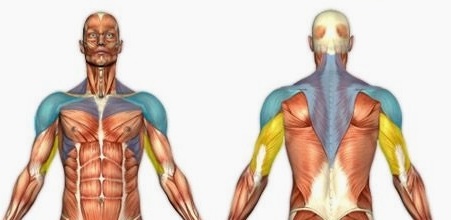The standing overhead press
Some of the myths that accompany this exercise is that it is damaging to the knees and/or the lower back.
Those myths come out of people who have damaged their knees or back as a result of training in a way which doesn’t treat the body as a system.
Proper, balanced training strengthens the knees and the lower back so THEY TOO can sustain the pressure.
This exercise works directly on the shoulder muscles (deltoids). But the key thing is that it trains the whole body, enhances stability and balance. Compared to seated shoulder press, it influences the lower back and your legs by demanding more stability to hold the weights. Compared to dumbbells, with standing overhead press you can lift much heavier than with dumbbells. If you know how to overhead press properly, you will be able to get the maximum benefits of this exercise.
Some people avoid this exercise as it places much effort on the lower back and the knees. That’s true, if you incorrectly perform the exercise or with far heavier weights than what you really need. Or if you specialize in avoiding leg exercises as squats! (Yes, squats work lower back as well). It is better to start lightly and increase periodically than to give up beforehand. And most importantly, this exercise compared to the seated ones or the ones performed with dumbbells, produces far greater response of HGH and testosterone.
The right way how to overhead press
- Place the bar with the weights on the squat rack, on a chest-level height. Hold the bar with your palms facing outward. Your grip should be 5-6 centimeters wider than your shoulders.
- Slightly bend you knees and straighten them placing the bar on your upper chest.
- Step back from the rack. Your feet should be on a hip-width stance.
- While you lift the bar, tilt your head back slightly for the bar to pass. When the bar has passed your head, return your head into its position where it was. Exhale while you lift the bar up.
- In the same time at the end of the movement, shrug your shoulders and fully straighten and lock your arms.
- Slowly lower the bar down to your upper chest, while inhaling. Tilt you head back again so the bar can pass.
- Lift the bar again.
- The bar must be at 90 degrees’ angle with the floor, i.e. moving up and down in the same straight line, without tilting it backward or forward.
- Repeat as necessary.
Muscles trained with the overhead press:
 Shoulders (mostly front delts, then middle and rear delts)
Shoulders (mostly front delts, then middle and rear delts)- Triceps
- Traps
- Abs (through balancing the weights)
- Lower back (through balancing the weights)
- Legs (through balancing the weights)
This shoulder exercise will significantly help you in performing the bench press.
The most powerful exercises